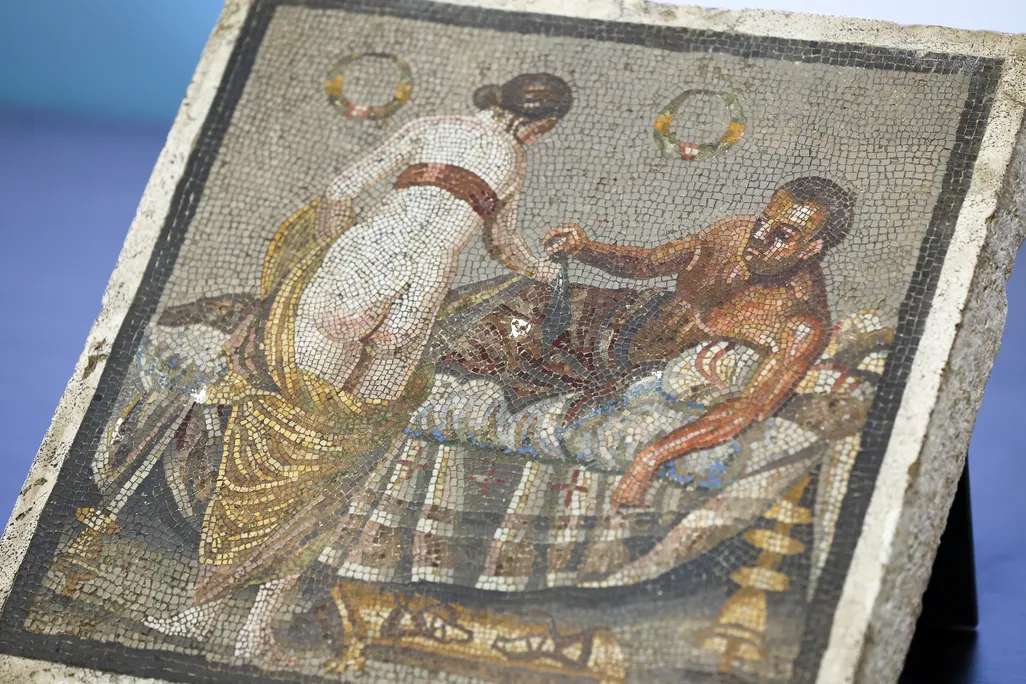Ancient Erotic Mosaic Stolen From Pompeii During World War II Finally Returns Home
A Nazi captain gave artwork, which depicts an intimate Roman romance, to a civilian. When he died, his heirs decided to return the piece to Italy

During World War II, a German military captain acquired a stolen erotic mosaic while stationed in Italy. The ancient artwork came from in or around Pompeii, the city buried by Mount Vesuvius’ eruption in 79 C.E.
The Nazi captain gave the piece to a civilian, who died with it in his possession. A few years ago, the owner’s heirs contacted Italy’s Carabinieri Command for the Protection of Cultural Heritage, asking for help returning their relative’s stolen artwork.
The mosaic was repatriated to Italy in 2023. Now, the piece has arrived at the Archaeological Park of Pompeii, where it will be displayed for visitors.
Quick facts: Why is the ancient city of Pompeii so well-preserved?
- When Mount Vesuvius erupted in 79 C.E., it covered the city in more than 16 feet of volcanic debris.
- Archaeologists rediscovered Pompeii in the late 16th century.
“Every looted artifact that returns is a wound that heals, so we express our gratitude to the protection unit for the work they have done,” Gabriel Zuchtriegel, the director of the archaeological park, says in a statement, per a translation by the Guardian’s Angela Giuffrida. “The wound lies not so much in the material value of the work but in its historical value, a value that is severely compromised by the illicit trafficking of antiquities.”
Set on a square slab of travertine (a type of limestone), the mosaic depicts an intimate scene between two lovers. A man lies on a bed, while a woman stands facing him, her back to the viewer. The man’s right arm reaches towards the woman, as if poised to drop something in her outstretched hand.
Experts say the mosaic is of “extraordinary cultural interest,” according to the Associated Press’ Giada Zampano and Andrea Rosa. The work likely dates to between the first century B.C.E. and first century C.E.
/https://tf-cmsv2-smithsonianmag-media.s3.amazonaws.com/filer_public/b4/20/b4206e1f-d8d5-4e17-9410-0c84d3702b95/518270430_757645986660080_9154367734295061060_n.jpeg)
“It is the moment when the theme of domestic love becomes an artistic subject,” Zuchtriegel tells the AP. “While the Hellenistic period, from the fourth to the first century B.C.E., exalted the passion of mythological and heroic figures, now we see a new theme.”
While some artworks in Pompeii depict magnificent battles, the newly returned mosaic features a simple domestic scene. The man’s expression “seems almost a little bored,” Zuchtriegel says, as reported by Reuters’ Gavin Jones.
Researchers think the mosaic may have once been embedded in the floor of a bedroom, according to the statement. Experts are already planning to conduct new analyses to learn more about its origins. But while it most likely came from the area around Mount Vesuvius, its exact provenance may remain a mystery.
/https://tf-cmsv2-smithsonianmag-media.s3.amazonaws.com/filer_public/ea/4c/ea4cb205-22b1-463d-abb1-919105d5c62b/518273802_757645883326757_1073743565601743384_n.jpeg)
The theft is “like tearing out a page from a book, a novel,” said Zuchtriegel at a recent news conference, per the New York Times’ Lynsey Chutel. “It’s not just this object, but the entire history that is compromised.”
During World War II, the mosaic was stolen from the Naples area. The captain, who was in charge of military supply chains, may have been the thief, though it’s possible he acquired it from someone else.
The heirs’ decision to return the mosaic suggests that ownership of looted art is now considered “a heavy burden,” Zuchtriegel tells the AP. “We see that often in the many letters we receive from people who may have stolen just a stone, to bring home a piece of Pompeii.”
/https://tf-cmsv2-smithsonianmag-media.s3.amazonaws.com/accounts/headshot/Sonja_headshot.png)
